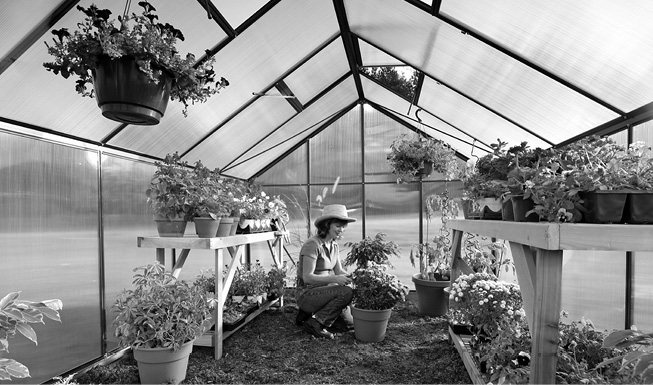“Who loves a garden loves a greenhouse too.”
— William Cowper, English Poet
Legend has it that as a child, America’s first president, George Washington, chopped down a cherry tree. Honest to a fault, he confessed. “I can’t tell a lie. I did cut it with my hatchet.”
Regardless of this tale’s veracity, Washington more than made up for it later. It is well known that he was a dedicated and proud gardener. In fact, on November 23, 1794, he wrote to William Pearce, and said, “I have no objection to any sober or orderly person’s gratifying their curiosity in viewing the buildings, Gardens, & ca. about Mount Vernon.”
He devoted large areas of his Mount Vernon home to planting, and when he was able to be at home, he and his gardeners tested their skills by growing plants that were exotic to Virginia in a greenhouse, which provided a winter refuge for tropical and semi-tropical plants, such as oranges, lemons, limes, coffee and aloe. A fire was maintained to keep the greenhouse warm.
In June of 1787, around the time Washington was inaugurated as America’s first president, the British ship, HMS Bounty, was purchased by the Royal Navy to sail to Tahiti and acquire breadfruit plants. The plants were to be transported to the West Indies where they would be grown as an inexpensive food source.
The tale of Mutiny On The Bounty, is the story of the mutiny that occurred on the HMS Bounty on April 28, 1789 against Captain William Bligh. What many do not know is that the Bounty contained a greenhouse. Before her voyage, she was refitted to accommodate the breadfruit she would transport. The renowned British botanist and naturalist Sir Joseph Banks designed many of the changes to accommodate these live plants. In fact, he supervised the modifications to the great cabin, essentially turning it into a floating greenhouse that contained racks for potted plants and a floor that was covered in lead. The scuppers (drains) at the forward corners of the cabin were used to divert excess fresh water from the pots into barrels that were kept below deck to collect the water runoff for reuse.
One thing remains clear, where greenhouse gardening was once the domain of scientists and the wealthy, it is now available to us all.
The passion many people feel for the environment and its bounties are expressed through a simple, yet satisfying activity: gardening. Those who love to grow things yearn for the basic pleasures of planting and caring for flowers, herbs, and vegetables in a garden.
But for many people who live in areas of the country that experience harsh winter climates, gardening year-round is impossible. Because the seasons can limit a gardener’s efforts, homeowners can delight even more in a greenhouse, which offers an almost year-round growing environment.
A greenhouse is a structure, usually enclosed by glazed glass or plastic. This covering helps the greenhouse to maintain a comfortable temperature throughout the year. Because it provides favorable climactic conditions for growth, a greenhouse environment supports all kinds of plants, vegetables, flowers, and fruits — literally the bounty of nature enclosed. Best of all, it gives you, the gardener, a good measure of control over the greenhouse environment.
A greenhouse can be built in a variety of shapes and sizes, and often becomes a unique expression of the person who tends to the plants and herbs housed within. Depending on what part of the country the greenhouse is located, there are a variety of plants that can be grown.
Is the gardener growing tomatoes for his or her family? Or, is he or she planting seedlings to be used in a garden next spring? Whatever plants it will shelter and nurture, a greenhouse is a haven for those people who feel compelled to sink their hands into the earth and yield from it all manners of natural wonders.
In this book, you also will become familiar with different types of greenhouses, their basic features, and how to determine which one will best fit your gardening needs. You will discover how to select the best site on your property to build a greenhouse, as well as how to plan your greenhouse, what tools you will need, and how to build it safely. You will become familiar with the step-by-step instructions for building a basic greenhouse from a kit, as well as with the methods for a conventional, do-it-yourself project. You will learn how to build a foundation for a greenhouse, as well as the sidewalls, roof frames, end walls, windows, and doors, as well as how to attach the covering. Finally, you will discover some tips for successfully managing your greenhouse once it is built.
The amount of money and time that is devoted to building a greenhouse can vary greatly from structure to structure. Much depends on the size of the structure and the extent to which it will be customized. Other issues, such as type of greenhouse, location, and climate will also have a significant impact.
It should be noted that the structure of the book is a bit different from others you may have read about building greenhouses. The book begins by explaining the history of greenhouses, followed by the types of greenhouses that you can build. This is normal enough, but then we delve into finding where to put your greenhouse, as well as the foundation to lay down. It may seem odd to talk about building a foundation and then go right into building plans for greenhouses in the following chapters, but there is a method to this madness. The foundation for your greenhouse will be the same for pretty much any greenhouse that you build. A concrete foundation can work for a hoop greenhouse, A-Frame greenhouse, and even a lean-to greenhouse. However, so will a dirt floor, gravel foundation, or wood foundation. So it was important to get the foundation part of the greenhouse out of the way as we did not need to repeat ourselves over and over through the chapters about building a foundation.
The following chapters — after learning the basics of greenhouses — are all about putting together greenhouses, including various plans that you can use. After that, you will learn about greenhouse maintenance, extra accessories and giving your greenhouse its own unique flair.

Photo courtesy of Juliana America, LLC.
